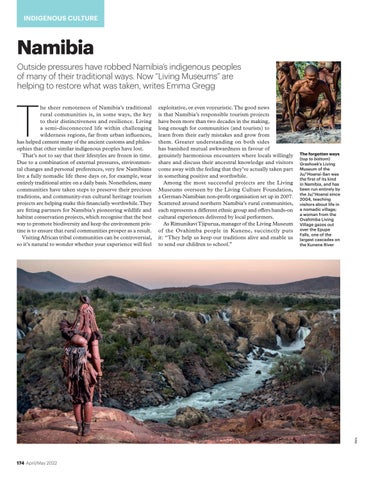INDIGENOUS CULTURE
REPRO OP
Outside pressures have robbed Namibia’s indigenous peoples of many of their traditional ways. Now “Living Museums” are helping to restore what was taken, writes Emma Gregg
SUBS
T
ART PRODUCTION CLIENT
he sheer remoteness of Namibia’s traditional rural communities is, in some ways, the key to their distinctiveness and resilience. Living a semi-disconnected life within challenging wilderness regions, far from urban influences, has helped cement many of the ancient customs and philosophies that other similar indigenous peoples have lost. That’s not to say that their lifestyles are frozen in time. Due to a combination of external pressures, environmental changes and personal preferences, very few Namibians live a fully nomadic life these days or, for example, wear entirely traditional attire on a daily basis. Nonetheless, many communities have taken steps to preserve their precious traditions, and community-run cultural heritage tourism projects are helping make this financially worthwhile. They are fitting partners for Namibia’s pioneering wildlife and habitat conservation projects, which recognise that the best way to promote biodiversity and keep the environment pristine is to ensure that rural communities prosper as a result. Visiting African tribal communities can be controversial, so it’s natural to wonder whether your experience will feel
exploitative, or even voyeuristic. The good news is that Namibia’s responsible tourism projects have been more than two decades in the making, long enough for communities (and tourists) to learn from their early mistakes and grow from them. Greater understanding on both sides has banished mutual awkwardness in favour of genuinely harmonious encounters where locals willingly share and discuss their ancestral knowledge and visitors come away with the feeling that they’ve actually taken part in something positive and worthwhile. Among the most successful projects are the Living Museums overseen by the Living Culture Foundation, a German-Namibian non-profit organisation set up in 2007. Scattered around northern Namibia’s rural communities, each represents a different ethnic group and offers hands-on cultural experiences delivered by local performers. As Rimunikavi Tjipurua, manager of the Living Museum of the Ovahimba people in Kunene, succinctly puts it: “They help us keep our traditions alive and enable us to send our children to school.”
The forgotten ways (top to bottom) Grashoek’s Living Museum of the Ju/’Hoansi-San was the first of its kind in Namibia, and has been run entirely by the Ju/’Hoansi since 2004, teaching visitors about life in a nomadic village; a woman from the Ovahimba Living Village gazes out over the Epupe Falls, one of the largest cascades on the Kunene River
Alamy
VERSION
Namibia
174 April/May 2022
BLACK YELLOW MAGENTA CYAN






















